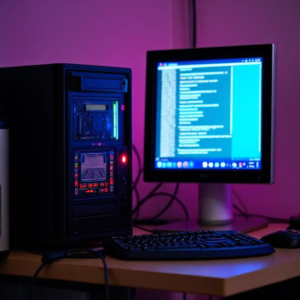1. What is a Computer?
- A computer is an electronic device capable of processing data and performing tasks according to instructions (programs).
- It includes hardware (physical components) and software (programs or operating systems that run the hardware).

2. Components of a Computer
- Hardware: Physical parts of a computer.
- Central Processing Unit (CPU): The brain of the computer where processing and execution occur.
- Memory (RAM): Temporary storage used to store data that is actively being used or processed.
- Storage: Long-term storage for data (e.g., Hard Drive, SSD).
- Input Devices: Devices used to input data into the computer (e.g., keyboard, mouse).
- Output Devices: Devices used to display or output data (e.g., monitor, printer).
- Motherboard: The main circuit board that holds all the components together and allows communication between them.
- Software: Programs and applications that tell the computer how to perform tasks.
- Operating System (OS): The system software that manages hardware resources and provides common services for computer programs (e.g., Windows, macOS, Linux).
- Application Software: Software that performs specific tasks for users (e.g., Microsoft Word, web browsers).
3. Input and Output
- Input: Data sent into the computer from external devices (e.g., keyboard, mouse).
- Output: Data processed by the computer and sent out to external devices (e.g., display, speakers).
4. Storage Devices
- Hard Drive (HDD): Traditional magnetic storage device.
- Solid State Drive (SSD): A faster, more reliable storage option than HDD.
- Optical Discs: (e.g., CDs, DVDs) Used for storing data that can be read by optical devices.
- Flash Drives and External Storage: Portable storage devices, often using solid-state memory.
5. Operating System (OS)
- A set of software that manages computer hardware and software resources and provides services for computer programs.
- Examples: Windows, macOS, Linux, Android, iOS.
- Functions: Memory management, file system management, process management, device management, etc.
6. Software Types
- System Software: Software that manages the hardware of the computer (e.g., operating systems, device drivers).
- Application Software: Programs that perform specific tasks for the user (e.g., word processors, web browsers, games).
7. Networking Concepts
- Internet: A global network that connects millions of private, public, academic, and government networks.
- Local Area Network (LAN): A network that connects computers within a limited area, like an office or home.
- Wi-Fi: A wireless networking technology that allows devices to communicate without physical cables.
- IP Address: A unique identifier for devices on a network.
- Router: A device that forwards data between computer networks.
8. File Management
- Files: Collections of data or information stored on a computer (e.g., text files, images).
- Folders/Directories: Containers for organizing files.
- File Extensions: Suffixes that indicate the file type (e.g., .txt for text files, .jpg for images).
- File System: A system for organizing and storing files (e.g., NTFS for Windows, HFS+ for macOS).
9. Computer Security
- Antivirus Software: Software designed to detect, prevent, and remove malware.
- Firewall: A security system that monitors and controls incoming and outgoing network traffic.
- Encryption: A process of converting data into a code to prevent unauthorized access.
- Password Protection: Security measure requiring users to enter a password to access accounts or files.
10. Basic Programming Concepts
- Programming Languages: Languages used to write software (e.g., Python, Java, C++).
- Algorithms: Step-by-step instructions to perform tasks or solve problems.
- Variables: Storage locations for data in programs.
- Loops: Programming structures that repeat a set of instructions.
- Functions: Reusable blocks of code designed to perform specific tasks.
11. Computer Peripherals
- Printers: Devices that output data to paper.
- Scanners: Devices that input data from paper (e.g., converting text or images to digital format).
- Speakers: Devices that output sound.
- Webcams: Devices for video input.
12. Cloud Computing
- Storing and accessing data and applications over the internet, rather than on local computers or hard drives.
- Examples: Google Drive, Dropbox, Microsoft OneDrive.
13. Multimedia
- Images: Graphics, photos, and pictures displayed on a computer.
- Audio: Sound files (e.g., MP3, WAV).
- Video: Moving visual media (e.g., MP4, AVI).
- Video Games: Interactive multimedia applications.
14. Computer Maintenance
- Software Updates: Installing updates to improve functionality and security.
- Disk Cleanup: Removing unnecessary files to free up space and improve performance.
- Defragmentation: Reorganizing fragmented data on a disk to improve speed (for HDDs, not required for SSDs).
15. Basic Troubleshooting
- Error Messages: Alerts from the computer indicating problems.
- Rebooting: Restarting the computer to resolve issues.
- System Restore: Returning the system to a previous working state.
These basic concepts provide a solid foundation for understanding how computers work and how to use them effectively. Let me know if you want more details on any specific area.
Tags: Algorithms, antivirus software, application software, audio, C++, CDs, central processing unit, Cloud Computing, Computer, computer maintenance, Computer Security, CPU, data processing, defragmentation, device drivers, directories, disk cleanup, Dropbox, DVDs, electronic device, Encryption, error messages, external storage, file extensions, file management, File System, files, firewall, flash drives, folders, functions, Google Drive, Hard Drive, Hardware, HFS+, images, Input, Input Devices, internet, IP address, Java, Keyboard, LAN, Linux, Local Area Network, Loops, macOS, Memory, Microsoft OneDrive, Monitor, Motherboard, Mouse, multimedia, Networking, NTFS, Operating System, optical discs, OS, output, output devices, password protection, Peripherals, printer, printers, Programming Languages, programs, Python, RAM, rebooting, router, scanners, Software, software updates, speakers, SSD, storage, system restore, system software, troubleshooting, Variables, video, video games, webcams, Wi-Fi, Windows


